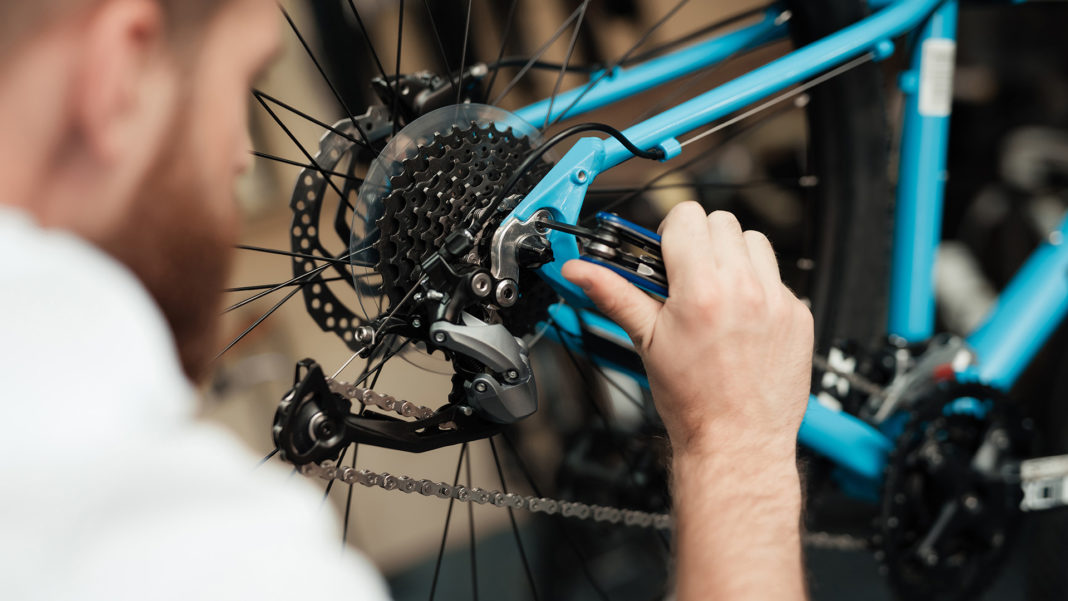In a year with bike parts on high demand and in short supply, everyone should be taking extra care of their bikes. A clean and properly lubed chain will last much longer than a greasy chain that is black, or a dry, squeaky chain. Either way, too much lube that collects dirt, or too little lube can cause premature wear and need replacement much earlier. Regular inspection of the entire bike can catch loose bolts or parts so they can be taken care of before becoming a larger problem.
The best way to take care of your bike between visits to the bike shop is to keep your bike clean and your drivetrain clean and greased. The best time to do this is as soon as you finish your ride. Using a regular, dry, clean rag will get most of the dust off of a frame and wheels as well as the braking surface (rim or disk). If the bike is a little dirtier than just dust, some bike cleaner in a spray bottle and that same rag will help remove some of the road grime from the bike.
Using a bike-specific cleaner can help with contamination of your braking surface to reduce any noise and maintain your braking power next time you ride. To degrease the chain and drivetrain, a chain degreaser and rag will do the job. Just spray the degreaser on the rag, and use it to scrub the majority of the old lube off the chain. If it needs more of a clean, you can spray the degreaser directly onto the chain and use the rag to wipe everything off. Just be careful to keep the dirty degreaser away from any braking surfaces.
After you have cleaned your chain and gears, you will need to re-lube the chain. Squeeze one drop of chain lube on each link of the chain from the inside. You can do this by spinning the pedals backwards. Once the whole chain is covered spin the pedals backwards two or three times to get the lube fully into the chain. Allow that to sit for at least 15 minutes, then wipe any excess lube off the chain. Excess lube will only attract more dirt making for a very dirty chain.
At the beginning of every ride, a quick check of the bike should be done. First, and most important to safety, is to make sure the brakes are working well. Pull the brake levers and make sure they are engaging on the rim or the disk and that the wheels are moving freely. The second thing to check is that the quick-release axles are tight.
Next, do a quick visual inspection of the bike. Check the tires for cuts or wear, check that all the bolts are tight, look at the gears and see that the derailleur is not going to move into the wheel.
Finally, before setting out, check your tire pressure; 80 to 100 psi for road bikes, 40 to 60 psi for city bikes, 20 to 30 psi for mountain bikes. When in doubt, your tires should have a recommended tire pressure on the side walls.
And the best part – get out there, ride, and don’t forget to smile!

Tools & Supplies
- Bike Wash
- Chain degreaser
- Chain lube
- Brush set or microfiber rag
- Metric hex wrench set
- Floor pump
Since cleaning and lubrication are the most important maintenance activities, the items to complete that work should be your first purchases. Bike-specific cleaners are easier on paint and on seals that protect the moving parts of the bike. Chain degreasers are specifically made to remove the dirt and lube from chains.For fair weather cyclists, a dry lube is recommended since it will attract less dust.
The main tool you will need is a metric hex wrench set, which will be able to take care of any axles for wheels, and all the little bolts on the bike for handlebars, stems, saddles, bottle cages etc.
Lastly, a good floor pump to check tire pressure is the best way to prevent flats. Tires and tubes will not hold air forever.
Read This Story in Our Outdoor Summer Digital Edition
Get outside and play!
We’ve covered DIY Bike Maintenance, Wildlife Travel, Open Water Swimming, Ultramarathon Training, Paddleboarding, Family Adventures, and Dogs and a Cat to watch on Instagram! Work out with Canada’s Top Fitness Instructors and be inspired by our Athletes with IMPACT.


















